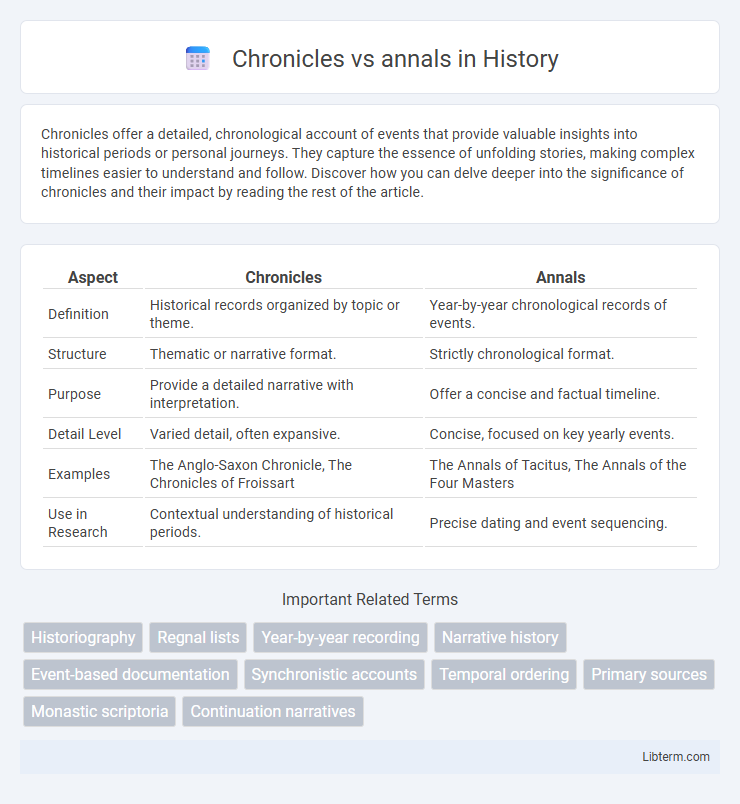Chronicles offer a detailed, chronological account of events that provide valuable insights into historical periods or personal journeys. They capture the essence of unfolding stories, making complex timelines easier to understand and follow. Discover how you can delve deeper into the significance of chronicles and their impact by reading the rest of the article.
Table of Comparison
| Aspect | Chronicles | Annals |
|---|---|---|
| Definition | Historical records organized by topic or theme. | Year-by-year chronological records of events. |
| Structure | Thematic or narrative format. | Strictly chronological format. |
| Purpose | Provide a detailed narrative with interpretation. | Offer a concise and factual timeline. |
| Detail Level | Varied detail, often expansive. | Concise, focused on key yearly events. |
| Examples | The Anglo-Saxon Chronicle, The Chronicles of Froissart | The Annals of Tacitus, The Annals of the Four Masters |
| Use in Research | Contextual understanding of historical periods. | Precise dating and event sequencing. |
Definition of Chronicles and Annals
Chronicles are historical accounts organized by topic or narrative flow, emphasizing detailed descriptions of events and contextual background. Annals are chronological records of yearly events, primarily listing occurrences in a linear, date-by-date format without extensive interpretation. Both serve as primary sources in historiography but differ in structure and depth of detail.
Historical Purpose of Chronicles and Annals
Chronicles serve to narrate historical events in a continuous, detailed manner, often emphasizing the cultural or religious significance of the period they cover. Annals provide a concise, year-by-year record of occurrences designed primarily for chronological reference, focusing on factual accuracy rather than narrative depth. The historical purpose of chronicles lies in preserving a coherent story of human experience, while annals function as a foundational chronological framework for historians.
Structural Differences Between Chronicles and Annals
Chronicles present historical events in a thematic or narrative structure, often grouping related incidents to highlight cause and effect, while annals follow a strictly chronological format, recording events year by year without interpretation. Chronicles may include detailed descriptions, commentary, and thematic organization, whereas annals prioritize brevity and chronological order, focusing on documenting events as they occurred. The structural difference lies in chronicles providing context and storytelling, contrasting with the annals' straightforward, date-driven entries.
Narrative Style Comparison
Chronicles present a continuous, detailed narrative focusing on events in chronological order with rich descriptions and context, enhancing reader engagement through storytelling techniques. Annals adopt a concise, year-by-year listing of events, emphasizing factual precision over narrative flow, which serves as a straightforward historical record. The narrative style of chronicles aims to connect events causally and thematically, while annals prioritize brevity and chronological accuracy without elaboration.
Chronological Organization in Chronicles vs Annals
Chronicles present events in a strict chronological order, often grouping narratives by years with detailed explanations of each occurrence, reflecting a continuous historical flow. Annals also organize information year-by-year but emphasize brevity, listing significant events in a concise, factual manner with minimal narrative embellishment. This chronological organization makes chronicles more suited for storytelling, while annals serve as succinct historical records.
Sources and Authorship
Chronicles often rely on firsthand accounts, eyewitness testimonies, and official records, authored by monks, clerics, or court historians with direct access to events. Annals mainly compile annual entries derived from existing documents, oral traditions, and bureaucratic reports, frequently anonymized or created by multiple contributors over time. The distinct source base and authorship reflect their purpose: chronicles aim for narrative coherence, while annals prioritize chronological documentation.
Regional Examples: Chronicles and Annals in World History
Medieval Europe's Anglo-Saxon Chronicle offers a detailed annual record of events, serving as a prime example of annals with its year-by-year format emphasizing historical chronology. In contrast, the Irish Annals, such as the Annals of Ulster, combine chronological entries with narrative elements, blurring the line between annals and chronicles. Meanwhile, Japanese croniclers utilized Nihon Shoki to blend mythological narratives and historical records, illustrating how chronicles incorporate thematic storytelling alongside factual events.
Reliability and Objectivity in Historical Recording
Chronicles provide a sequential narrative of events often based on eyewitness accounts, making them valuable for understanding historical context but sometimes less objective due to potential author bias. Annals focus on concise, year-by-year entries that emphasize factual recording over interpretation, which enhances their reliability as a reference for specific dates and occurrences. The objectivity of annals is generally higher because they avoid elaboration, while chronicles offer richer detail but require critical evaluation for bias and accuracy.
Influence on Modern Historiography
Chronicles and annals both serve as primary sources for understanding historical events, but chronicles often provide detailed narrative accounts while annals focus on concise, chronological listings. The influence of chronicles on modern historiography lies in their rich context and storytelling approach, which helps historians analyze causality and cultural perspectives. In contrast, annals contribute to the establishment of precise timelines and factual accuracy, essential for chronological frameworks in historical research.
Key Takeaways: Choosing Chronicles or Annals
Chronicles present a narrative style with detailed storytelling and chronological events focused on historical context and cultural insights, making them ideal for readers seeking comprehensive historical understanding. Annals emphasize concise, year-by-year records primarily listing events without extensive interpretation, suited for researchers prioritizing factual timelines and concise reference. Choosing between chronicles and annals depends on the need for detailed narrative versus succinct chronological data in historical research.
Chronicles Infographic

 libterm.com
libterm.com